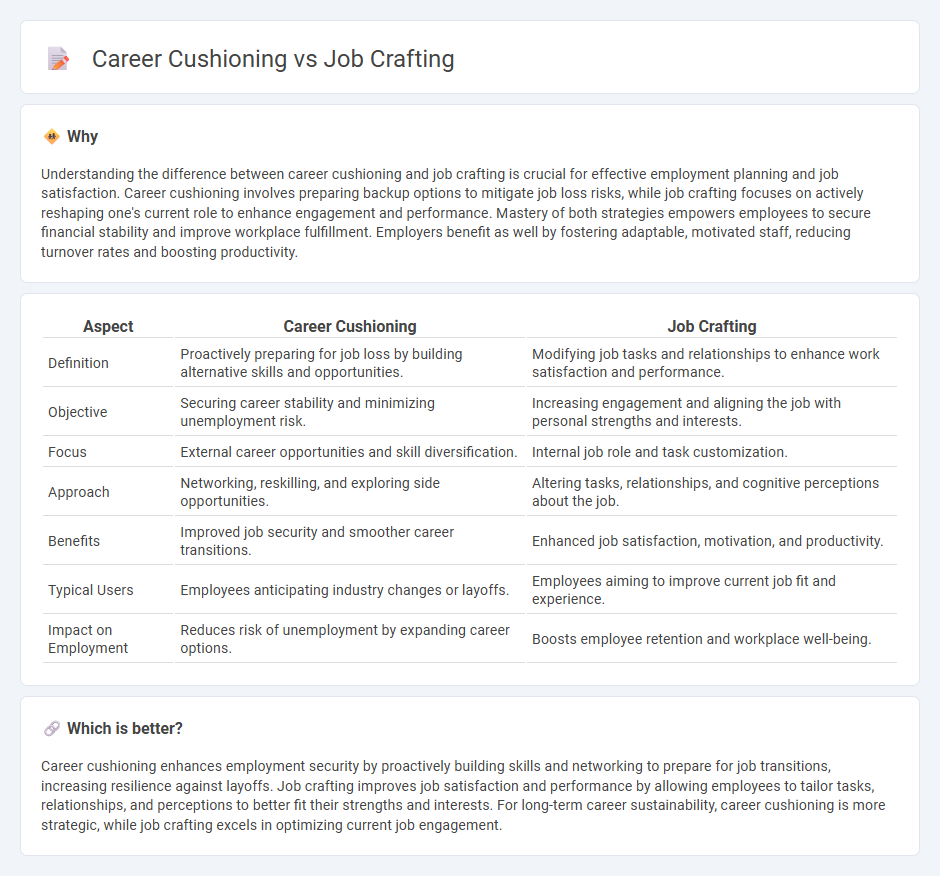
Career cushioning involves building skills and networks to enhance job security amid uncertain employment landscapes, while job crafting empowers employees to redesign their current roles for greater engagement and satisfaction. Both strategies foster resilience and adaptability in evolving job markets. Explore how these approaches can transform your professional journey.
Why it is important
Understanding the difference between career cushioning and job crafting is crucial for effective employment planning and job satisfaction. Career cushioning involves preparing backup options to mitigate job loss risks, while job crafting focuses on actively reshaping one's current role to enhance engagement and performance. Mastery of both strategies empowers employees to secure financial stability and improve workplace fulfillment. Employers benefit as well by fostering adaptable, motivated staff, reducing turnover rates and boosting productivity.
Comparison Table
| Aspect | Career Cushioning | Job Crafting |
|---|---|---|
| Definition | Proactively preparing for job loss by building alternative skills and opportunities. | Modifying job tasks and relationships to enhance work satisfaction and performance. |
| Objective | Securing career stability and minimizing unemployment risk. | Increasing engagement and aligning the job with personal strengths and interests. |
| Focus | External career opportunities and skill diversification. | Internal job role and task customization. |
| Approach | Networking, reskilling, and exploring side opportunities. | Altering tasks, relationships, and cognitive perceptions about the job. |
| Benefits | Improved job security and smoother career transitions. | Enhanced job satisfaction, motivation, and productivity. |
| Typical Users | Employees anticipating industry changes or layoffs. | Employees aiming to improve current job fit and experience. |
| Impact on Employment | Reduces risk of unemployment by expanding career options. | Boosts employee retention and workplace well-being. |
Which is better?
Career cushioning enhances employment security by proactively building skills and networking to prepare for job transitions, increasing resilience against layoffs. Job crafting improves job satisfaction and performance by allowing employees to tailor tasks, relationships, and perceptions to better fit their strengths and interests. For long-term career sustainability, career cushioning is more strategic, while job crafting excels in optimizing current job engagement.
Connection
Career cushioning involves building alternative skills and networks to enhance job security, which complements job crafting by empowering employees to reshape their current roles for greater satisfaction and performance. Both strategies foster proactive adaptation in the workplace, enabling individuals to navigate career transitions smoothly and maintain employment resilience. Integrating career cushioning with job crafting supports sustained professional growth and mitigates risks associated with job displacement.
Key Terms
Personalization
Job crafting involves employees actively shaping their current roles to better fit their skills, interests, and values, enhancing job satisfaction and performance. Career cushioning, on the other hand, focuses on strategically preparing for future career shifts by building skills, networks, and opportunities outside the current job. Explore how personalization in job crafting and career cushioning can empower you to tailor your career path effectively.
Adaptability
Job crafting enhances adaptability by allowing employees to reshape their current roles, aligning tasks with their strengths and interests to improve engagement and performance. Career cushioning builds adaptability by encouraging professionals to develop diverse skills and networks, preparing for potential job market changes or uncertainties. Explore more insights on how these strategies foster workplace resilience and career growth.
Security
Job crafting involves employees proactively redesigning their current roles to enhance job satisfaction and security by aligning tasks with strengths and interests. Career cushioning focuses on building external security nets through skill development and networking to prepare for potential job loss or transitions. Explore more to understand how these strategies can bolster your professional stability.
Source and External Links
Job crafting - Job crafting is a self-initiated, proactive work design process where employees change the tasks, interactions, or perceptions of their job to better fit their strengths, interests, and sense of meaning.
Job Crafting: What HR Professionals Need to Know - Job crafting involves making small, intentional changes to tasks, skills, relationships, wellbeing, or purpose in one's job, often leading to improved job satisfaction and effectiveness.
Job Crafting LLC: Job Crafting Store - The Job Crafting(tm) Exercise is an interactive tool and workshop approach that helps individuals and organizations redesign jobs for better alignment with personal values and strengths, enhancing engagement and fulfillment.
 dowidth.com
dowidth.com